Contents


Every year, gardeners are becoming more and more interested in various innovations among crops, in particular, they are striving to add something new to their garden. One of the unconditional trends of recent years is the mass passion for blackberries – a fast-growing, high-yielding shrub that is a close relative of the raspberry familiar from childhood. However, the cultivation of such a black berry is accompanied by some difficulties: the bushes are afraid of frost, require some care, and also hurt the gardener when harvesting. Painfully “prickly character” in a capricious berry! And now, thanks to overseas breeders, a variety has finally appeared that is completely devoid of sharp thorns – the thornless blackberry Thornless.
Description and characteristics of the variety
This variety of blackberries is very similar to Thornfri, but differs in larger berries – each reaches a weight of up to 15 g. Fruiting does not begin until August – it is during this period that the first berries ripen: very sweet, black and dense. The culture forms a powerful bush, with upright shoots and dark green leaves. The variety is characterized by large white flowers, collected in lush inflorescences. The flowering period begins in June. Such a blackberry is not particularly whimsical in choosing the soil: it can grow in any soil composition, but to get the best result, the bush needs to be fed.
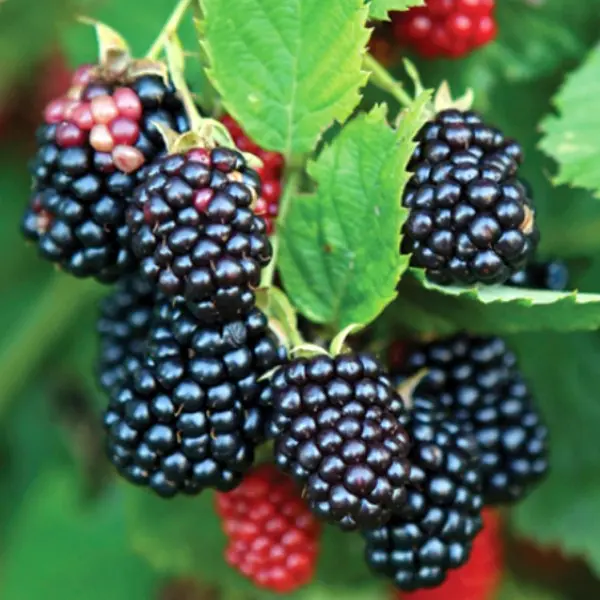
Blackberries of the Thornless variety tolerate transportation well and retain their presentation for a long time.
Thornless combines several varieties of blackberries, which have a common feature – the absence of sharp thorns.
Oregon Thornless blackberry is a thornless plant with creeping shoots reaching 4 meters in length. Fruits with excellent taste, but not very large. The variety is high-yielding and very decorative, thanks to attractive carved leaves. Blackberry with average winter hardiness, requires mandatory protection from winter frosts;
Hull Thornless is another thornless blackberry that produces sweet berries. This hybrid variety was bred in the USA and is best suited for growing in those latitudes where the temperature does not fall below 6-8 degrees. The shoots of such plants can reach a length of 5 meters, and they themselves are quite powerful. The variety has a high yield.
Austin Thornless is a thornless, mid-season and unpretentious culture, with long, powerful shoots. Form large fruits – an average of 8-9 grams. The berries are sweet, with a sour note. The variety is self-pollinating.
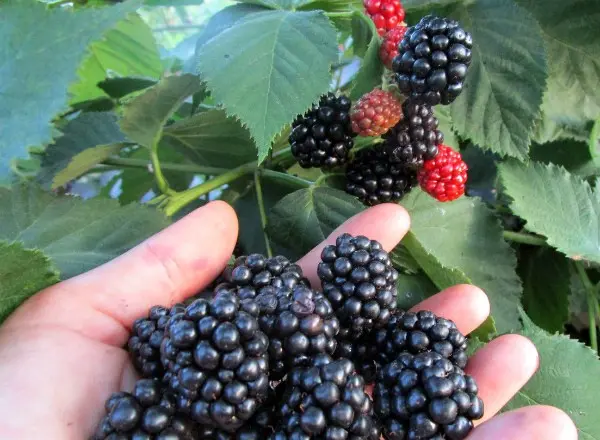
The Merton Thornless variety completes today’s review of the thornless blackberry – a creeping plant with powerful faceted shoots without thorns. The culture is considered winter-hardy: it can tolerate frosts down to -30 degrees. The shrub is resistant to diseases, rarely affected by pests. Forms a large multiple brush of ovaries – up to 50 medium-sized berries with a sweet and sour taste. It bears fruit from the beginning of August until the end of September, allowing you to collect up to 10 kilograms of berries from each bush. The fruits are distinguished by excellent qualities – they do not crumple, do not lose their presentation for a long time.
Features of growing in garden plots
The main obstacle that summer residents face in the process of growing blackberries is low temperatures in winter and lighting in the selected area.
But there is a way out: frost, damaging the above-ground shoots of the culture, will not be terrible for it if you organize a decent shelter for the shrub from the cold, lowering the shoots and fixing them on the surface of the soil. Another option is complete pruning of the above-ground part of the bush. In this case, all shoots are removed, only the root system remains, which, according to gardeners, is not afraid of frost. But if you are looking to get the maximum yield, you should not experiment, and yet, organize a shelter.
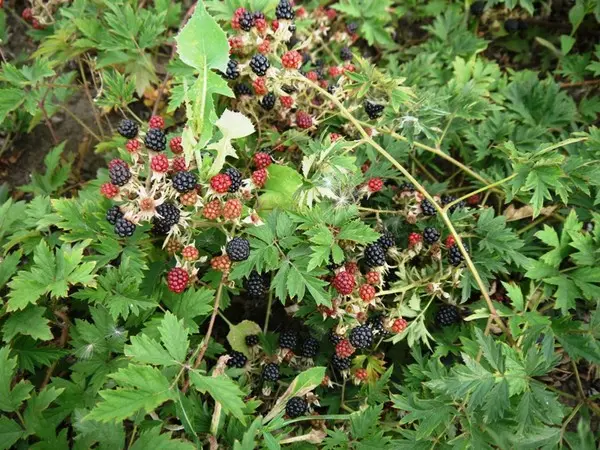
The thornless blackberry of the Oregon Thornless variety gives long and flexible lashes, so it is most convenient to grow such a crop using special supports – trellises. As the shoots grow, they are fan-shaped fixed on supports. This method greatly facilitates not only the process of harvesting and caring for the plant, but also has a positive effect on the volume of fruiting: the branches do not obscure each other, and the ovaries get the right amount of sunlight.
Landing technology
Thornless is best planted in a permanent open place in the spring, when the warm weather has finally set in (a young seedling may not survive planting for the winter, even if it is properly covered).
It is necessary to prepare a plot for blackberries in the fall: apply organic fertilizers (humus or compost), dig the soil to the depth of a shovel bayonet and leave it for the winter.
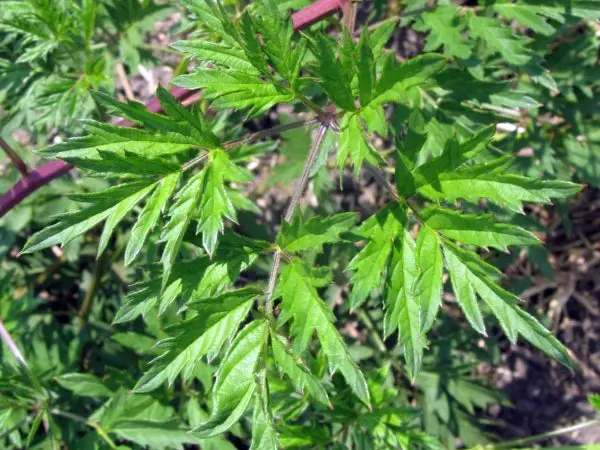
In the spring, holes of 50×50 cm in size are formed on the selected site, leaving a distance between them of about 1,5 m, and adhering to a row spacing of up to 2,5 m. The seedling must be carefully cut – shorten the lashes to 25 cm, removing all weak or damaged shoots. The planted plant is watered abundantly, at the rate of 1 bucket of water per bush and mulched.
Thinness of care
The Thornless variety needs standard plant care manipulations: blackberry beds need to be regularly weeded to get rid of weeds (not only are weeds a habitat for many pests, they also take away nutrients from the soil from the bushes), loosen the soil (to improve air access to the root system), water regularly and do not forget about regular top dressing (it is enough to fertilize the bushes once a year, introducing humus or compost).
With the advent of autumn, blackberries need more careful care. The whip must be lowered from the support and carefully examined. All damaged and fruit-bearing branches must be completely removed, leaving only young shoots that have grown during this season for the winter. In this form, the plant bends down to the ground, is fixed and covered with a protective cover until next spring.
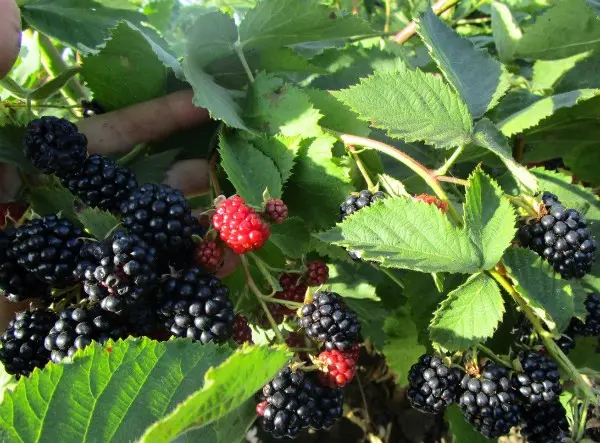
Reproduction
Thornless blackberries, like any other, are best propagated by lateral root processes. But the trouble is that Thornless gives extremely few of these shoots. Therefore, many gardeners have gotten used to propagating this blackberry by dropping the tops of the shoots, fixing it on the ground so that the growth point is in close contact with the ground.
Diseases and pests
Surprisingly, for all its delicacy in matters of temperature, Thornless is rarely affected by diseases and pests. Sometimes on individual hearths you can notice gray rot, which does not have a mass character (appears on the fruits of the lower branches that are in contact with the ground), and sometimes aphids may appear (to combat it, spray the bushes with an infusion of tobacco dust (200 g), water (10 l ) and laundry soap (50 g).

Video “Planting Blackberries Oregon Thornles”
This video is about planting an Oregon Thornles blackberry in the fall, with an open root system.









